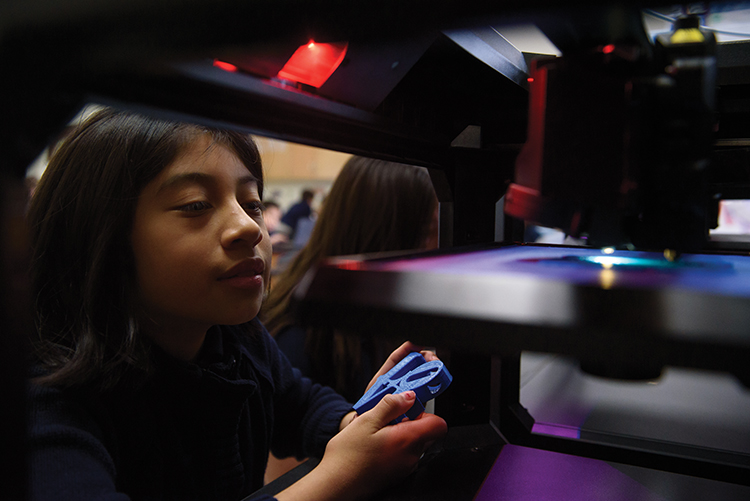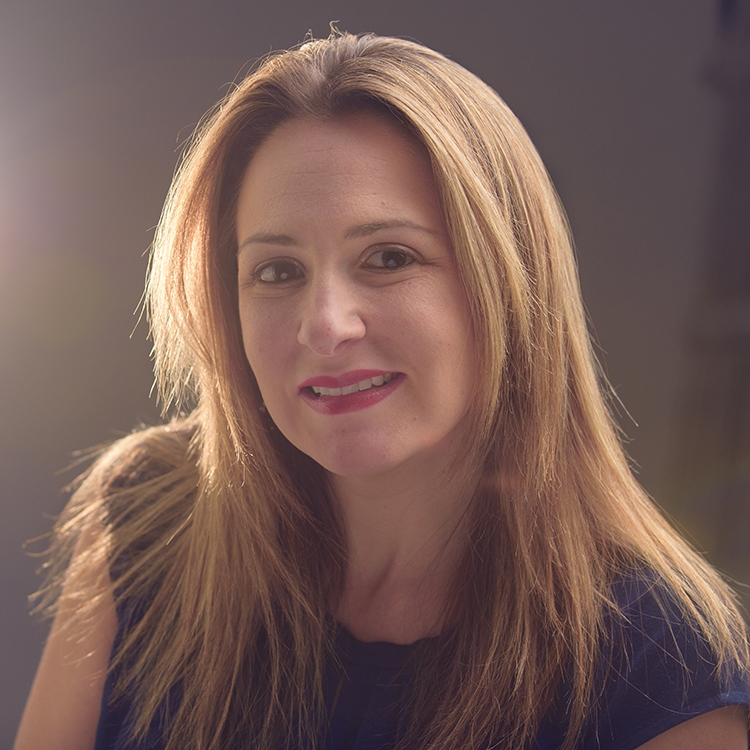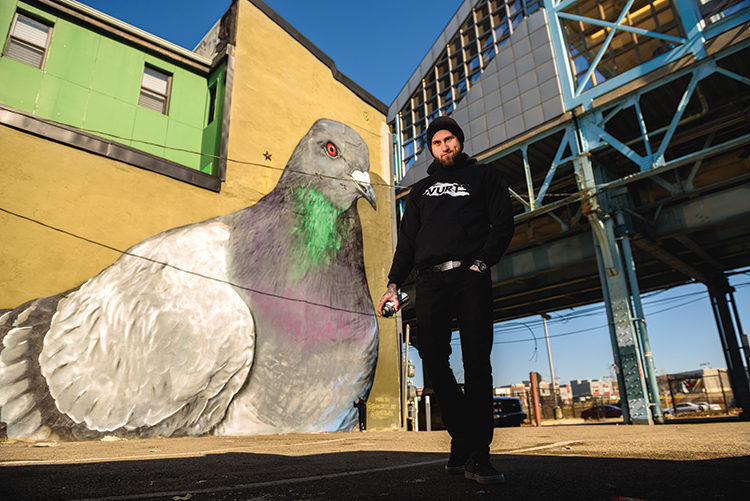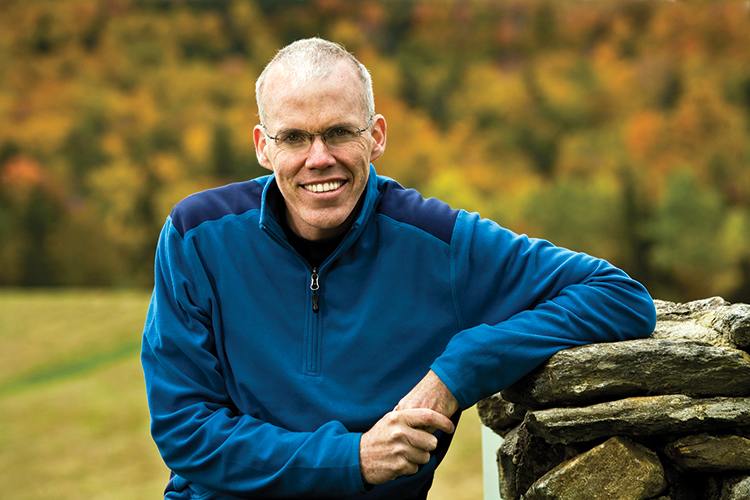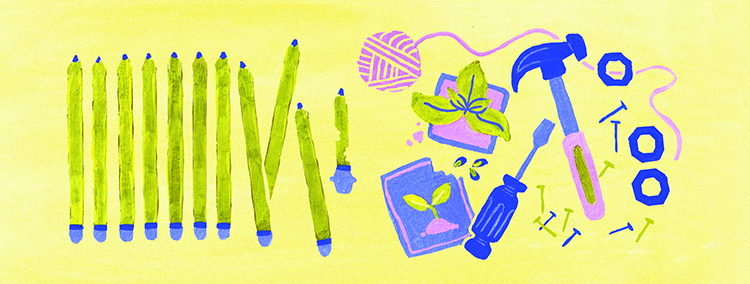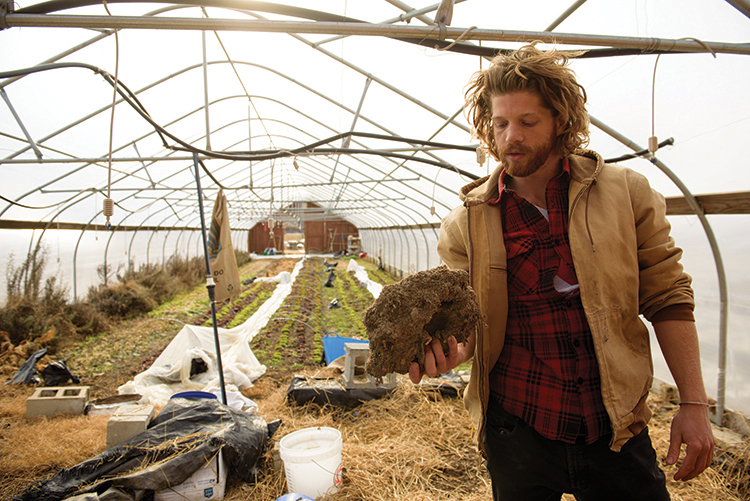by Steve Neumann
photos by Kriston Jae Bethel
Hilary Hamilton, a founding teacher at Science Leadership Academy Middle School located in Powelton Village, is leading an exuberant army of young students sporting headphones through their neighborhood on an unusually warm December day. Like new shoots fooled by a hint of spring, they’re eager to display the fruit of their learning. Along with teachers, family members and community members, they are embarking on a walking tour of the school’s neighborhood that includes podcasts explaining the significance of historical sites in their neighborhood. Each podcast was researched and recorded entirely by students from Hamilton’s and fellow humanities teacher Sarah Bower-Grieco’s classes.
“The Bravery in the Neighborhood Project was meant to combine situated bravery in history with situated bravery in yourself,” Hamilton says.
Earlier this year, the class focused on those times in history when it was considered courageous to read and write, studying the plight of enslaved blacks in America in the 1700s, women in the 1850s and English-language learners in public schools today. Students then had to write their own autobiographies of instances when they had to be brave in reading and writing.
Mosadi LaFair, a sixth-grade girl who lives in West Philly, reflected on the time she had to be brave in learning how to read:
There was a point in my life when I didn’t know how to read, and all the other kids in my class were ahead in everything. But I was too afraid to ask for help. I thought kids would make fun of me for not knowing how to read.
At the end of the day I didn’t have any bravery to think that I was doing awesome. I felt like I was dumb. When I got home from school I was so mad that I couldn’t read the words or write the words, but my mom said I had to go tutoring today and I didn’t feel like going to tutoring. But I had to.
So when I went to tutoring the tutor asked me to spell the word ‘usually’ and I spelled it.
And at that moment I was like ‘WHAT!’
The site Mosadi researched for the walking tour is 40th and Lancaster, the location of Martin Luther King Jr.’s “Freedom Now” speech in 1965, now memorialized with a bust and a mural on the side of a building.
Nolen Gerwer, another sixth-grader at the school, clearly enjoyed both the activity and the feeling of being valued. “It’s something that I enjoy doing, because people get to hear me talk, and people can learn from me when I’m doing a podcast,” he says.
One of Nolen’s best friends, Amoz Lee, a new sixth-grader at the school, agrees. “I think doing podcasts are awesome,” he says. “Especially the research about my topic, the Title and Trust Company, which got shut down by the Great Depression. I thought that was really intriguing.”
The SLA podcast is an example of project-based learning in which kids are tasked with completing a real-world task. This technique has its roots in the progressive education movement, which advocated for more student-centered classroom approaches that were believed to promote “deeper learning” through the active exploration of real-world problems.
In 2008, education researchers Brigid Barron and Linda Darling-Hammond conducted a review of the research literature on project-based learning, concluding: “Students engaged in inquiry-based learning develop content knowledge and learn increasingly important twenty-first century skills, such as the ability to work in teams, solve complex problems, and to apply knowledge gained through one lesson or task to other circumstances.”
However, a 2017 working paper, published with the support of MDRC (formerly Manpower Demonstration Research Corporation) and Lucas Education Research, suggests that the evidence for the effectiveness of project-based learning in improving student outcomes is “promising but not proven.”
The authors did note, however, that some research on project-based learning showed positive academic and noncognitive gains for both suburban and urban students, especially in science and social-studies classes.
State of Education
The work that Hamilton and schools like Science Leadership Academy are doing is situated in a political context that could best be described as a battleground.
Journalist Dana Goldstein documents this in her 2014 book “The Teachers Wars”: “Teachers have been embattled by politicians, philanthropists, intellectuals, business leaders, social scientists, activists on both the Right and Left, parents, and even one another.”
The Philadelphia School District has been an especially grueling combat zone.
A major point of contention has been the School Reform Commission, created by the state of Pennsylvania in 2001 after the school district was declared financially distressed. The SRC closed many public schools in the district and allowed more charter schools to be established. Critics of charters say that they lack transparency, divert funds away from needy neighborhood schools and, on top of all that, don’t necessarily produce better academic outcomes. To the relief of many educators in Philadelphia, the SRC just voted to disband itself this year.
But as recently as March 2013, the SRC voted to close 23 Philadelphia public schools because of the ongoing funding crisis and the flight to charter schools.
To make matters worse, an analysis conducted by the Pennsylvania Department of Education found that, despite the state agreeing to provide additional funding to help the district stave off its budget crisis, “Philadelphia has received less state school aid than its standing as one of Pennsylvania’s poorer communities would merit, if that money were distributed according to need,” reported The Philadelphia Inquirer in November.
But like the dogged persistence of a rose that grows in concrete, to paraphrase the late rapper Tupac Shakur, Philadelphia continues to grapple with the best way to ensure the sustainability of its public schools.
Over the past several years, the school district, under Superintendent William Hite Jr., has opened seven new high schools as part of the school district’s Innovation Network. The ultimate goal is to reinvent and reinvigorate the concept of the school for those students who have been ill-served by the existing system.
Like Science Leadership Academy, the Workshop School—also part of the Innovation Network—employs a project-based learning model.
Rebecca Coven is in her second year of teaching there, and, like many new teachers, she wondered how she could get her students to be passionate about something. She now concedes that this was a misconception.
She found that her students were passionate about a lot of things: They’d talk about gender inequality, they’d talk about race and mass incarceration. They were fired up and angry, but they didn’t know how to take action, or didn’t understand that their voices could be heard and that they could, in fact, make a difference in the world.
“It’s through project-based learning that I can help give them the tools,” Coven says, “and show them the different ways they can not just get fired up but channel that energy into action.”
One project Coven’s 10th-grade class did this semester was centered around the topic of mass incarceration. Earlier this year, her class visited the museum at Eastern State Penitentiary on Fairmount Avenue. They then spent several weeks becoming “experts” on aspects of mass incarceration, thinking critically about the action steps they mig
ht take to address it. The final deliverable for the project is for the students to create their own exhibit and present it at a public symposium at the penitentiary itself.
“I’m going to give you guys an image from one exhibit from [Eastern State Penitentiary] that we saw,” Coven says to her class, “and a piece of poster paper so you can answer these questions.”
The questions Coven puts up on her whiteboard are: What does this museum exhibit teach you about mass incarceration? What is effective about this museum exhibit? Does this museum exhibit encourage you to take action? If not, what might be added to encourage people to take action?
“When you come up with your own museum exhibit,” Coven continues, “you’re going to try to encourage other people to take action to reduce the amount of people in prison.”
When the students are done with their posters, each group takes a turn presenting them to the class.
Salena Robinson, 15, leads her group’s discussion. The exhibit they had to analyze was a confession board with letters from some people who are in prison combined with some who are visitors, and students had to figure out who wrote which letters.
“What I think they should have done instead of putting just the letters up there,” Salena says, “was put up a quote from each letter. People don’t go to a museum to read and read and read—they want to see interesting stuff, crazy cool stuff. Who’s going to read at an old prison?”
Unlike some of her peers, though, Salena isn’t as passionate about the mass incarceration project.
“I’m not much of an activist,” she says. “Like, ‘Oh, my God, black rights!’ I think they’re important, and I stand by those people who do that every day, because it takes guts to go out there and be like, ‘Oh, black rights matter!’ It’s just that I don’t have the energy or the personality. I’m more of an introvert, overall.”
But Salena is very passionate about creating art. One of the defining projects for her was one called Digital Memoir, in which students had to reflect on a time that was especially educative for them.
“For me,” Salena says, “it was learning that my lack of sleep could actually help out with my talent of art. So I decided to draw my whole memoir.”
Salena says some students decided to use photos, others used one single photo combined with a voiceover. When everyone in the class was done, they presented them all.
“I’m not really a reality type of person,” she says. “I’m more of a fantasy person. Like, ‘Oh, my gosh, colors! Vibrancy!’ I like art. I want to stick with art.”
As for Salena’s plans after the Workshop School, she wants to go to California for college.
“I want to get into animation, and it just seems like if I go to where Disney or Pixar is, then I’ll get the best experience there,” she says.
Salena has also been working on a comic strip whose main character is named Rando.
“He’s a cat, I guess,” Salena says. “He’s like a superhero; he always comes in to save people, and people look up to him. But he’s like Deadpool in a way. He’s a reluctant superhero.”
In addition to Science Leadership Academy and the Workshop School, one of the newest schools in the Innovation Network is Vaux Big Picture High School, which opened its doors in September. Vaux is located in a historic art deco building in the Sharswood section of North Philadelphia.
Although run by Big Picture Learning—a national organization known for promoting a high school education centered around students’ interests and career goals—it draws students primarily from its neighborhood, and the teachers are members of the Philadelphia Federation of Teachers. However, it is funded similarly to a charter school in that the district provides a lump sum per student, and the school has the autonomy to spend that money as it sees fit.
Jessica McAtamney, assistant principal at the school, says Vaux is all about finding kids’ passions and putting them into action in internships with local businesses and organizations.
“It’s all student-centered,” she says, “so it really meets the students where they are.”
Vaux has an exhibition component to its curriculum that lets students present their work each quarter, based on a learning plan that’s individualized for them. McAtamney says it helps students narrow down what it is they like to do, and what they’re good at.
“These students develop a relationship with the teacher, and that person becomes that student’s advocate,” she says. “They become their mentor and their coach, and they help navigate that kid through the system.”
Vaux also has a systemized block where the students spend a significant amount of time off campus, in a component called Real-World Learning. Here, they’re exposed to all sorts of potential career pathways.
“It’s trying to engage them in something meaningful that will spark them careerwise,” McAtamney says. “They have to prepare to go on the trip, and when they get there they have to look critically at the space to see what career opportunities you could gain either from being employed by that organization or, if you studied within that field, what you could get from it.”
Over at the U School, also in North Philadelphia, humanities teacher Sam Reed III—whose students affectionately refer to him as simply “Reed”—says they hang their hat on three principles: competency-based learning, restorative practices and learning that connects students to 21st-century skills.
“We’re not tied down to traditional grades, although the work is aligned to Common Core standards,” Reed says. “We’re really focused on what it is that students can do, and then monitoring that and honoring where they are.”
In a competency-based model, students are grouped by how independent they are as learners rather than by grade level.
So some students are semi-autonomous, where they’re in a classroom, but it’s not run like a traditional one. There may be some kids who are working on one
project, and some who are working on another project, and the teacher is there supporting and facilitating that.
But there are also classes that are more teacher-directed, and those are where every student is generally doing the same thing at the same time, and the teacher is building them up to the point where they can have more autonomy.
Beyond the Innovation Network
While the Innovation Network shows early promise and continues to grow, dedicated and proactive public school teachers throughout the school district look for ways to compensate for the funding inequities that plague the city.
“I think people need to understand that there are amazing things that happen in schools across Philadelphia every day,” says Chris Lehmann, co-principal at Science Leadership Academy in Center City. “The people who work within them are serious-minded people who believe in doing their best for the kids they serve.”
A prime example of this is Ismael Jimenez, who teaches African-American history at Kensington Creative and Performing Arts High School.
“If you travel down the river of tears,” he begins, “in a boat of broken promises, under heavy fog, it’s hard to be clear exactly what your knowledge is.”
Jimenez repeats this line by Talib Kweli, hip-hop artist and social activist, like a mantra throughout the lesson.
On his whiteboard today he puts up a quote from Brazilian educator and activist Paulo Freire’s widely read book, “Pedagogy of the Oppressed”: “The oppressed want at any cost to resemble the oppressors.”
“If we want to resemble the powerful,” Jimenez says to the class, “and you’re not powerful, what are the consequences of that?”
“You let them define you,” says 11th-grader Brittany Diaz. “You’re corrupted.”
The class is at the end of a unit called “American Economic F
oundations: The Institution of Slavery.” Today they’re considering the story of Phillis Wheatley, an African girl enslaved at age 7 and educated in the household of the prominent Wheatley family of Boston in 1761.
In 1773, Wheatley became the first African-American—and the second woman—to publish a book of poems. Having been immersed in the values of white society, she came to view white culture as better than her native African culture—as attested to in the final line of one of her poems: “Remember, Christians, Negroes, black as Cain, May be refin’d and join th’ angelic train.”
Jimenez encourages the class to make real-world connections to Wheatley’s story, followed by a whole-class dialogue.
“Use your knowledge about the beliefs, accomplishments and death of Phillis Wheatley to develop a short essay relating Phillis Wheatley’s life to the experiences of African-Americans generally throughout American history,” Jimenez says.
Because Jimenez’s school isn’t part of the Innovation Network, it still relies mostly on traditional curriculum and pedagogy. Jimenez’s class has become a small garden of roses in a mostly concrete landscape.
“I only like his class,” says 11th-grader José Toledo. “It opens up your mind to things about the world that you never would have thought of.”
José’s classmate, Mai Nguyen, agrees. “On the first day,” she says, “he told us we won’t pass his class without thinking. Every day he gives us a quote and some analysis, and how it ties into real-world situations.
“It urges you to think rather than just sitting there and copying from the board,” she continues. “It really makes you wanna stand up.”
Down in South Philadelphia, Jayda Pugliese has taken things into her own hands regarding resources. Her fifth-grade class at Andrew Jackson Elementary School just got its third 3-D printer, thanks to Pugliese’s own initiative.
Pugliese utilized a website called Donors Choose, a kind of GoFundMe for teachers, to get her first one from MakerBot. The price tag for the version she acquired was a steep $5,000.
But then MakerBot donated a second 3-D printer to her class after they saw an article about how her students made prosthetics. The third 3-D printer, a PrintrBot, is a little more old-school, but was also donated by the owner of a 3-D print supply company called Repkord.
“We’re making a prosthetic leg for a bulldog named Walter,” says fifth-grader Carla Luna. “He was in something terrible, like dogfighting. Now he’s in a happy home. Once we make the prosthetic, he’ll come visit us.”
“We’re also selling ‘LOVE’ statues to make money for different causes,” says Carla’s best friend, Dibanhi Ronzon. “Like one for a school in Africa, because they’re going to shut down if they don’t get enough money.”
“My philosophy is ensuring you make real life connections to anything that you do,” says
Pugliese, who also utilizes project-based learning in her classroom. “I have 71 percent of my students perform at advanced or proficient on their benchmarks, so clearly the connections I’m making are having a positive impact on their standardized test scores — and I’m not teaching to the test.”
Pugliese is also the recent recipient of the Milken Educator Award, which is comparable to winning an Oscar in education.
“You don’t apply for it,” Pugliese says. “All they tell you is that you’ve been selected by a blue ribbon panel within the state of Pennsylvania.”
Along with the award comes a $25,000 check.
“It’s ironic,” Pugliese says, “because a few months prior to winning, I had to drop out of a doctoral program because of financial difficulties. After I won, I was able to re-enroll the following semester. Now I’m about to start my dissertation.”
Since winning the Milken Educator Award, Pugliese has focused more on being a voice for teachers. She’s currently on the Pennsylvania Teachers Advisory Committee, a group that brings stories from the classroom to various stakeholders to help them understand the effects of funding inequities across the state.
“It shouldn’t be a balancing act for a school to decide whether they’re buying textbooks or having a school counselor, or getting a SmartBoard or having 36 kids in a class because they can’t afford another teacher,” she says.
The Philadelphia School District’s experiment to cultivate roses that can thrive in the traditional concrete of public education is “promising but not proven,” just like the project-based learning many of the schools use. There remain some considerable challenges.
One is how to define success in an environment of standardization and accountability that values test scores above all else.
Many Innovation Network schools are aware of this and have come up with systems that satisfy that need. At the Workshop School, for example, students present exhibitions at the end of each grading quarter where they get up and talk about their learning.
“We have a very robust, several-page, project-based report card,” says Simon Hauger, co-founder of the school. “And because we still live in a system that wants grades, we convert that work into grades that make sense to colleges and school district officials.”
Another potential obstacle is whether the kind of innovation these schools are experimenting with can work with the typical public school student.
In Philadelphia, as elsewhere around the country, many students reach high school with no other experience of education except the “banking concept” described by Freire in “Pedagogy of the Oppressed,” where students are viewed as passive piggy banks into which the coins of knowledge are deposited.
“Last year I had a student who used to call me Google, because he thought I had all the answers,” says Coven, of the Workshop School. “But when I told him I didn’t have them, and that we’re learning together, he started calling me Coach, because I was helping them develop their skills.”
Fortunately, it looks like the Philadelphia School District has at least some tacit support statewide in the form of Secretary of Education Pedro Rivera, himself a Philadelphia native from the Hunting Park section.
“We’ve been trying to build an accountability system that thinks differently,” Rivera said in an interview with Lancaster-based Fig magazine last year. “Right now the system doesn’t allow for a real clear articulation of agreement around how we’re allocating resources.”
“We have to understand,” he said, “that there is no one formula that works for every kid or every community. Education is hard work, and you’re always looking for the silver bullet. At the end of the day it’s just folks that are willing to do whatever it takes to educate kids.”
And that’s just what teachers in the school district have been doing, whether they’re part of the Innovation Network or not.
Reed at the U School realized this at some point during his 20-year career of teaching, which is why he calls himself an “accidental activist.”
“In this moment in education reform,” he wrote for Penn GSE’s Perspectives on Urban Education in the summer of 2013, “where teacher agency meets opportunity, it became important for me to embrace my role as a teacher activist.”
“As a teacher-activist deeply committed to transforming the landscape of education reform in my city,” he writes, “I think this moment offers opportunities for the District to support sustainable school-led transformations.”

